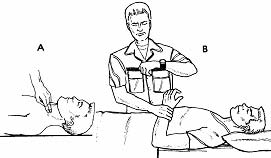The procedures for taking a patient’s pulse are given below.
a. Gather Materials.
You will need a clock or watch with a second hand, a pencil or pen, and something to write on (form, note pad, and so forth).
b. Verify Patient’s Identity.
If you are ordered to take a patient’s pulse, make sure that you are taking the pulse of the proper patient. For example, check the patient’s name on your orders against the name on his hospital identification bracelet or ask the patient his name.
NOTE: If you have already established the patient’s identity, this step is skipped.
c. Select Site.
Select a site for taking the patient’s pulse. Normally, the radial site is usually chosen. The brachial and the carotid sites are other commonly used locations. These sites are normally used because of their availability and because little or no clothing have to be removed in order to expose these sites. Other sites may be used when you wish to check the blood circulation to a specific body part.
d. Prepare Site.
Remove any clothing from over the site (open shirt for apical, remove boot and sock for dorsalis pedis, and so forth.). Then position the body part so that you can take the pulse easily.
NOTE: When taking a reclining patient’s radial pulse, place the patient’s arm across his chest as shown in figure 3-3. This will allow you to count his breaths after taking his pulse without having to move. The patient’s breathing pattern may change if he knows you are watching his breathing.

e. Locate Pulse.
Put the tips of your index finger and middle finger together and feel for the pulse by pressing down moderately with you fingertips on the site. If you cannot feel a pulse, move your fingertips around the area until you locate the pulse.
Do not use your thumb to search for the patient’s pulse. The thumb contains a blood vessel that is large enough for a pulse to be felt. If you use your thumb, the pulse that you find may be your own thumb pulse, not the patient’s pulse.
NOTE: Some people prefer to use three fingers to take a pulse.
f. Count Pulse Beats and Note Abnormalities.
Count the pulse beats felt during a 60-second period. Use the clock or watch. As you count the beats, note the strength and regularity (rhythm) of the beats.
NOTE: If you are using the dorsalis pedis site, use gentle pressure when palpating the artery. Too much pressure at this or other sites may press the artery closed and stop blood from flowing pass the site.
g. Record Pulse Rate.
By convention (general agreement), the patient’s pulse rate is recorded as an even number (ending in 0, 2, 4, 6, or 8). For example, if you counted 72 beats during the 60-second period, you would record “72.” Suppose, however, that you had counted 83 beats during the 60-second period. Would you record a pulse rate of “82” or “84”? By convention, an odd pulse rate is recorded as the next higher rate. Therefore, a pulse rate of 83 would be recorded as “84.”
NOTE: Once you have sufficient practice in taking pulses, you may wish to use a shorter method of determining the pulse rate of a patient with a regular pulse.
You may count the number of pulse beats that you feel during a 30-second period and multiply this number by 2. If, for example, you counted 37 pulse beats during a 30-second period, you would record “74” (37 X 2 = 74). This method will always give you an even number as your pulse rate. This method is used only if the patient has a regular rhythm.
If the patient has an irregular pulse, you must use a least a 60-second time period. Your SOP may require you to count the pulse beats for 120 seconds and divide by 2 if the patient’s pulse is irregular.
h. Record any Abnormalities.
If you noticed anything about the patient’s pulse that is not normal (irregular, intermittent, thready, bounding, and so forth), record your observations on the form or piece of paper. If the patient’s pulse is very different from the previous time (for example, a patient whose pulse was normal four hours ago and is now irregular), notify the appropriate nursing personnel.
i. Take Pulse at Other Sites, if Needed.
Sometimes a pulse cannot be taken accurately at a particular site because of blockage in the artery or other reasons. In such a case, you should take a pulse at another site in order to check your results. Sometimes a physician will order that the apical pulse be taken in addition to the pulse at another site. Such a procedure allows the physician to check the pulse at a particular site against the rate and characteristics of the actual heartbeat (apical pulse).
